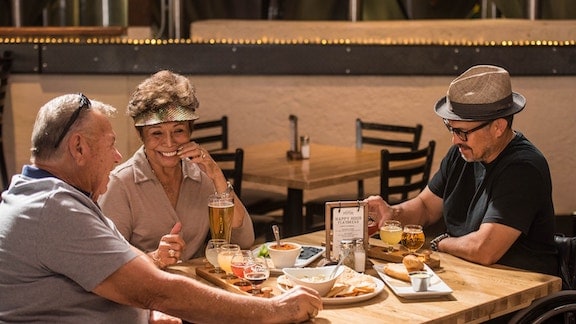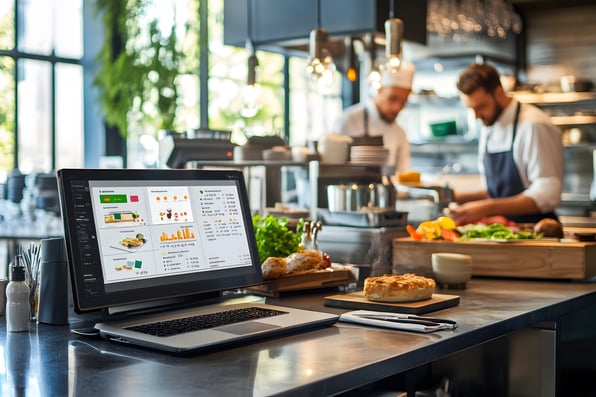Assisted Living Technology: What You Need To Know

Quality dining experiences are essential for residents' well-being and can significantly improve their daily lives. Assisted living technologies that streamline the process and allow for a wide range of nutritious, delicious meals can enhance their dining experience.
What Is Assisted Living Technology?
There are many types of assisted living technologies that can alleviate the problems faced by residents in senior living communities or simply make residents' daily activities easier and more enjoyable.
Assisted living technology can include devices such as personal trackers that help residents with health conditions monitor their vital signs like blood pressure or heart rate, updated Wi-Fi speeds and video calling apps that make it easier to keep in touch with family members, and built-in security and alarm systems that can provide residents with a sense of safety.
These various devices and technologies can greatly improve the quality of care received in residential communities and ensure that residents are happy, healthy, and enjoying their time in the community.
Introduction to Assisted Living Dining Technology
One area where assisted living technology provides major benefits is in the dining room. Providing timely, nutritious meals in a friendly environment is critical for residents' well-being. Assisted living technologies help ensure that meals are delivered quickly, safely, and correctly.
Dining technology for assisted living communities can also be a huge help for staff. Point-of-sale platforms like eMenuCHOICE streamline ordering and billing, eliminate cluttered paper tickets, and reduce human errors in meal preparation and delivery.
The Importance of Resident Dining in Assisted Living Communities
There's a reason why sharing a meal is often a key component of holidays and major life events: gathering with family and friends around a table is a meaningful way to form connections and build community.
Mealtimes are just as important, if not more so, in assisted living communities. Designated mealtimes can provide a sense of routine and structure for residents, and gathering with friends and peers in the dining room is a convenient way to socialize and foster relationships with other residents and staff.
Moving from home into an assisted living community can be a very difficult experience for residents, particularly people who may have lived in the same home for decades. Providing a variety of healthy, delicious foods at mealtimes and creating a warm environment in the dining room can help new residents feel more comfortable and give all residents a sense of home.
Technological Innovations Enhancing the Dining Experience
Advancements in assisted living technologies have produced numerous independent living solutions and play an important role in improving the dining experience for residents. Innovative point-of-sale systems expand residents' choice of meals and promote a feeling of independence that can often be lost when entering an assisted living community.
These systems can also keep track of personalized meal plans, allowing residents to eat nutritious, delicious meals that respect their dietary restrictions and avoid potential allergens.
Assisted living technologies also give servers and chefs a better experience. Systems that take orders, streamline billing, and integrate with EHRs to keep track of residents' dietary needs help prevent mistakes and alleviate stress on dining room staff. Assisted living technology is a key component that keeps dining rooms running efficiently without overburdening those preparing and serving the meals.
Personalized Meal Planning
Typically, traditional meal planning for residential communities involves serving the same food to all residents at each meal. Unfortunately, this severely limits food options for residents with allergies or specific diets.
Assisted living technologies can simplify meal planning while accommodating residents with dietary restrictions. With these technologies, residents can view images of what a meal will look like and order their meals in advance, allowing the kitchen to prepare only the ordered meals and cut down on costs and food waste.
This also expands the number of meal options you can offer residents. Additionally, residents' preferences and known allergens can be pulled from the EHR and automatically alert the wait staff in real time if they try to place an order the resident can't have. This helps create a safer environment while preventing meal preparation errors.
Innovative Dining Assistance Devices
Eating independently and confidently can be critical for a resident's mental health and well-being. Adaptive technologies, such as modified bowls, plates, and utensils, are used extensively to give residents more independence, even if they have chronic conditions that can impact their ability to eat.
More futuristic advancements are also coming into the dining room. Robotic devices and artificial intelligence, in particular, can assist residents who need extra help with eating, ease assisted living staff's workload, and free residents and staff up to interact and build relationships with each other in the dining room.
Enhance the Dining Environment and Ambiance With Smart Technology
Residential dining doesn't have to be a dreary, bland experience. Smart devices and thermostats can adjust room temperature and lighting before it detracts from residents' dining experiences and takes the pressure of monitoring the thermostat off caregivers and staff. They can also create a homey ambience with light adjustments, temperature control, and music, all of which can help residents feel more at home in a new environment.
Use Technology To Ensure Food Safety and Hygiene
Food safety and hygiene are critical to a fulfilling, healthy resident dining experience. Technology can help fill the gaps that unintentionally create unhygienic conditions and foodborne illnesses.
Tools that promote preventative measures in the kitchen, from sinks that make hand washing easier to sensors that detect when food has reached a safe temperature, can help ease the mental load of residence staff and improve food safety for residents overall.
Assisted living technology can also be useful if a foodborne outbreak does occur. Electronic point-of-sale systems that track each resident's food orders over days to weeks can help administrators trace the probable cause of the outbreak and remove the food items responsible.
The Future of Assisted Living Dining Technology
Assisted living technology promises to become an integral part of the residential living experience that can both ease the load on staff and ensure that residents are living their best life.
eMenuCHOICE is an innovative technology for assisted living communities that streamlines dining administration, helps provide a warm dining environment, and offers residents an expanded menu of healthy, delicious meals. eMenuCHOICE is available for a variety of assisted living communities and can be used for multiple dining formats, making it an easy choice for improving the quality of dining that your residents experience.



